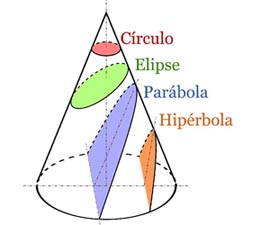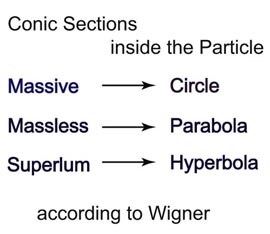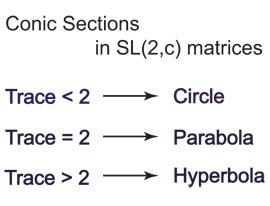Conic Sections

|
|
|

|
|
Click here for the source of this drawing. |
- The other lady was wearing a cone-shaped Vietnamese hat. What physics
can you extract from her hat? I am not the first person to ask this question.
- Greek observed there are three different curves, namely circle (ellipse),
hyperbola, and parabola. They then believed that they
should come from one source. Indeed, a circular cone provides all
of these curves.
Greeks believed that there are three fundamental elements in one thing. For instance, they thought one ideal woman consists of three different women carrying their respective virtues. Click here for a detailed story.
- Some years later, Isaac Newton formulated the law of gravity and
his second order differential equation. In so doing,
Newton was able to unify elliptic, hyperbolic, and parabolic orbits.
This aspect of physics is well known.

Step 1, Step 2.

- Click here for a more detailed
story about how Newton defined the history of physics. Quantum mechanics
was formulated to answer the question of why energy levels are discrete
for the hydrogen atom while the Rutherford scattering formula is
applicable to the electron-scattering. Here again, quantum mechanics was
formulated to unify the elliptic orbits of the electron and the hyperbolic
trajectory in Rutherford scattering. This aspect of modern physics is
also well known.
- Don't forget Einstein. Thanks to Feynman diagrams, we have a good idea of
the hyperbolic trajectories (scattering problems) in the Lorentz-covariant
world. How about
the hydrogen atom with discrete energy levels? How would this atom look
to an observer on a bicycle?
- This is John Bell's has this picture of the Lorentz-boosted hydrogen orbit in his book. This picture however does not explain why the its energy levels are discrete.
- Standing waves. How to Lorentz-boost?
- Evolution of the hydrogen atom the proton in the quark model.
- Quarks and Partons as two limiting cases of one Lorentz-covariant entity.
- Internal Space-time Symmetries. The first step toward what is going on
inside the proton is to understand the internal space-time symmetries of particles
in the Lorentz-covariant world. If the particle is at rest, then it has the
symmetry of the three-dimensional rotation group. If the particle gains its
speed, we have to worry about additional degrees of freedom.
- In his 1939 paper, Wigner
formulated this problem in terms of his little groups. The Lorentz group has
six degrees of freedom. If the four-momentum of a particle is fixed, it has
only three degrees of freedom, defining internal space-time symmetries. For
a massive particle at rest, it has three rotational degrees of freedom.
corresponding to the spin degrees of freedom.
If you like to have a reprint of Wigner's 1939 article, send your reuest to yskim@umd.edu.
- For massless particles, the
problem was not completely solved until 1990. In his original 1939 paper, the
internal space-time symmetry is isomorphic to the two-decisional Euclidean
group. The rotation corresponds to the helicity of the particle. There are
two translation-like degrees of freedom. It was later suggested by various
authors that they correspond to a gauge degree of freedom. However, why
the one-parameter gauge degree of freedom corresponds to two translational
degree of freedom. This question is addressed in the
1990 paper of Kim and Wigner.
- If the particle mass is imaginary, it moves faster than light, and is thus
not observable. Yet, recent trends in physics allow us to talk about
this possibility.
- Indeed, the transformation groups leaving those momenta invariant are like
O(3) (circle), like E(3) (linear or quadratic), and O(2,1) (hyperbolic)
respectively. Again the conic sections dominate even inside the particle.
- In spite of this simple picture of Wigner's view toward the internal
space-time symmetries, his 1939 paper is regarded as one of the most
difficult papers to understand. Yes, there have been and there still are
many rising stars in physics who claimed to have solved the poblem of
internal space-time symmetries. However, they carefully avoid Wigner's
classic paper on this problem. In so doing they are missing the main
point, and those stars fall down. Wigner's 1939 paper appears to be
the prescrition for their longevity.

- Sakura is the Japanese
word for cherry blossom. During a one-week period of spring every year,
the city of Washington (capital city of USA) becomes brightened by
full-blown Sakura flowers. I am indeed fortunate to live near this
city to enjoy this Sakura phenomenon every year.
However, the problem is they do not last too long, they disappear one week after their peak showing. It would be nice if someone could invent a botanic process to make them last longer. Likewise, the physics community is blessed with those Sakura-type physicists. We only wish they could stay longer to give us prolonged excitements.




- In his 1939 paper, Wigner
formulated this problem in terms of his little groups. The Lorentz group has
six degrees of freedom. If the four-momentum of a particle is fixed, it has
only three degrees of freedom, defining internal space-time symmetries. For
a massive particle at rest, it has three rotational degrees of freedom.
corresponding to the spin degrees of freedom.
- Post-Wignerian Approach. Wigner's original paper divides the particle
symmetry into three distinct classes. However, we can approach the
problem as one symmetry with three branches. This viewpoint can
be derived from our experience in ray and polarization optics. Modern
optics is largely a physics of two-by-two matrices from the group SL(2,c).
The generators of this group share the same set of commutation relations
with those for the group of four-by-four matrices performing Lorentz
transformations. For this reason, we can study Wigner's little groups,
or internal space-time symmetries, using optical instruments and two-by-two
matrices.
- Here is a review article
on this subject. It is easy to read this paper because it contains only two-by-two
matrices. The only non-trivial aspect of this paper is that not all those
two-by-two matrices can be diagonalized. The question is how to deal with it.
- I spent some years on this subject, and learned many lessons while writing papers with my younger colleagues. We learned the most important lessons from those referees who attempted to turn down our papers. For instance, we learned how to use the traces of two-by-two matrices in our logic from one of the hostile referees. It is my pleasure to thank them for writing those valuable reports for us.
- Here is a review article
on this subject. It is easy to read this paper because it contains only two-by-two
matrices. The only non-trivial aspect of this paper is that not all those
two-by-two matrices can be diagonalized. The question is how to deal with it.
- Let us choose a real positive number. It can be smaller than two, equal to two, or greater than two. It is so simple that even God can say this. Then God created elementary particles using two-by-two matrices.
Copyright@2012 by Y. S. Kim, unless otherwise specified. The portrait of Wigner and Einstein is by Bullent Atalay.